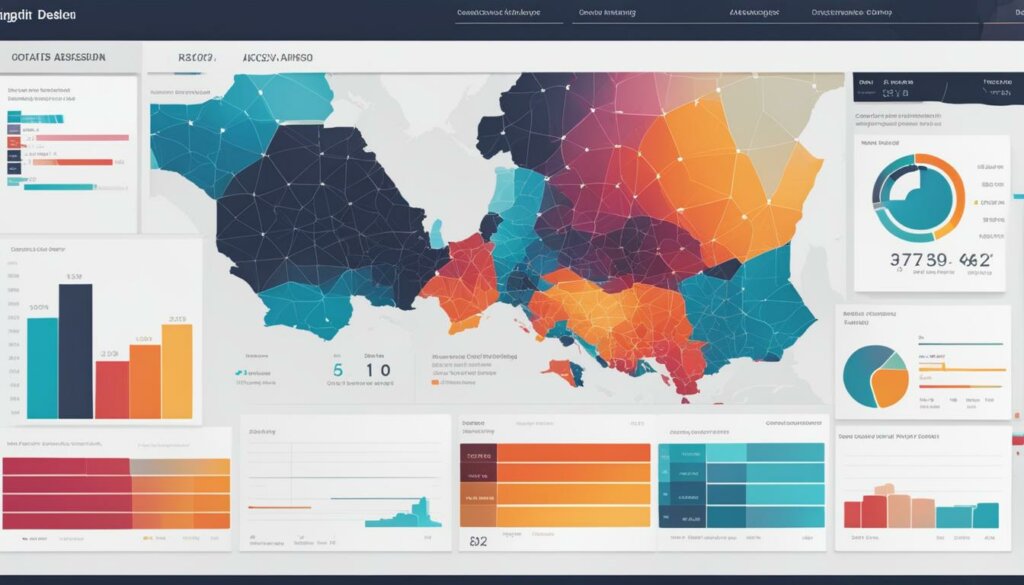Table of Contents
Big Data has become a powerful tool for companies to gain a competitive edge in various aspects of their business. By leveraging data analytics and mining techniques, companies can predict customer needs, increase customer satisfaction, and protect against fraud. The use of Big Data in financial analysis also helps inform sales growth and strategy. Proprietary and public data sources can be utilized to improve decision-making and identify trends for sales process improvement. Overall, Big Data offers numerous advantages that can drive businesses towards greater success.
Predicting Customer Needs
Data analysis plays a critical role in helping companies predict customer needs. By analyzing customer data and buying habits, businesses can gain valuable insights into what drives customer behavior and anticipate their future needs. This allows companies to proactively tailor their products or services to meet those needs, ultimately enhancing customer satisfaction and driving sales.
For example, data analysis can reveal patterns in customer purchasing behavior, such as recurring purchases or seasonal preferences. By identifying these patterns, businesses can forecast customer needs and adjust their inventory or marketing strategies accordingly. This data-driven approach minimizes the likelihood of stockouts or offering irrelevant products, ensuring that customers find what they need when they need it.
Additionally, predictive analytics techniques can be used to identify customers with similar profiles or buying habits. This enables businesses to identify potential cross-selling opportunities and target complementary products or services to relevant customers. By using predictive analytics to anticipate customer needs, companies can create personalized offerings that resonate with their target audience, increasing customer loyalty and driving revenue.
Table: Predictive Analytics Insights for Customer Needs
| Insights | Benefits |
|---|---|
| Anticipating seasonal demand | Optimized inventory management and sales forecasting |
| Identifying cross-selling opportunities | Increased revenue through targeted marketing strategies |
| Understanding customer preferences | Enhanced customer satisfaction and loyalty |
| Personalizing product recommendations | Improved customer experience and conversion rates |
By leveraging data analysis and predictive analytics, businesses can gain a competitive advantage by accurately predicting customer needs and offering tailored solutions. This not only enhances customer satisfaction but also drives business growth and boosts revenue.
Increasing Customer Satisfaction and Influencing Behavior
Gathering and analyzing real-time customer data enables businesses to anticipate customer wants and needs. By delivering personalized experiences and tailored offerings based on this data, companies can enhance customer satisfaction and loyalty. Real-time data analysis also allows businesses to influence customer behavior through targeted marketing strategies and personalized recommendations. By understanding customer preferences and delivering what they want, businesses can drive sales and build stronger relationships with their customer base.
One of the key advantages of leveraging real-time data is the ability to respond quickly to customer needs. By monitoring and analyzing customer interactions in real-time, businesses can identify patterns and trends, allowing them to make timely adjustments to their products or services. For example, if a particular product is receiving negative feedback or experiencing a decline in sales, businesses can quickly identify the issue and make necessary improvements to address customer concerns and increase satisfaction.
Furthermore, real-time data analysis enables businesses to craft targeted marketing strategies that resonate with their customers. By analyzing customer behavior and preferences, companies can deliver personalized recommendations and offers that cater to individual needs. This level of customization not only enhances customer satisfaction but also increases the likelihood of conversion and repeat business. For instance, an e-commerce company can use real-time data to recommend related products to customers based on their browsing history and purchase patterns, thereby influencing their buying decisions and driving higher sales.
An example of real-time data analysis in action:
“By analyzing real-time customer data, a leading online streaming platform was able to personalize its content recommendations for users, resulting in a 15% increase in customer satisfaction ratings. By understanding user preferences and viewing habits, the platform was able to deliver personalized content suggestions, ensuring that users were presented with shows and movies that aligned with their interests. This personalized approach not only improved customer satisfaction but also increased engagement and retention rates, leading to a boost in revenue.”
In conclusion, leveraging real-time data analysis plays a crucial role in increasing customer satisfaction and influencing behavior. By understanding customer preferences, businesses can deliver personalized experiences and targeted marketing strategies that not only meet customer needs but also drive sales and enhance customer loyalty. With the ability to respond quickly to customer feedback and trends, companies can stay ahead of the competition and create a positive and tailored experience for their customers.
| Data Analysis Benefits | Real-Time Data Analysis |
|---|---|
| Enhanced customer satisfaction | Proactive response to customer needs |
| Improved customer loyalty | Personalized marketing strategies |
| Increased sales and conversion rates | Timely adjustments based on customer behavior |
| Higher engagement and retention rates | Customized recommendations and offers |
Protecting Against Fraud
The ever-increasing use of Big Data has not only revolutionized business operations but has also introduced new challenges, including the risk of fraud. Companies now have access to vast amounts of transactional data that can be analyzed to detect and prevent fraudulent activities. By leveraging advanced analytics techniques, businesses can uncover hidden patterns and anomalies in the data, enabling them to identify potential risks and take proactive measures to protect their assets.
Fraud detection is a critical aspect of risk management, and transactional data plays a vital role in this process. By closely monitoring transactional data in real-time, companies can quickly detect suspicious activities and prevent fraudulent transactions from occurring. The ability to analyze large volumes of data in real-time allows for immediate action, reducing the financial impact on businesses and safeguarding their resources.
The power of Big Data in fraud detection lies in its ability to uncover complex relationships and patterns that may not be apparent through traditional methods. By analyzing transactional data from multiple sources, companies can gain a holistic view of their operations and identify potential red flags. This data-driven approach enables businesses to stay one step ahead of fraudsters and minimize the risks associated with fraudulent activities.
Furthermore, Big Data analytics can also help companies enhance their risk management strategies. By analyzing historical transactional data and identifying trends, businesses can develop predictive models that assess the likelihood of future fraudulent activities. These models enable companies to allocate resources effectively and implement targeted preventive measures to mitigate risks. By leveraging the power of data, businesses can protect their financial interests and maintain the trust of their customers.
| Fraud Detection Techniques | Benefits |
|---|---|
| Pattern Recognition | Identify irregularities and anomalies in transactional data |
| Machine Learning Algorithms | Continuously learn from data to improve fraud detection accuracy |
| Real-Time Monitoring | Immediately detect and prevent fraudulent activities |
| Predictive Analytics | Forecast future fraudulent activities based on historical data |
In conclusion, the use of Big Data in fraud detection and risk management has become indispensable for businesses in today’s digital landscape. By leveraging transactional data and applying advanced analytics techniques, companies can protect themselves against fraudulent activities, minimize financial losses, and ensure the integrity of their operations. As technology continues to evolve, businesses must proactively embrace Big Data as a powerful tool in their fight against fraud.

Financial Data for Sales Growth and Strategy
One of the key benefits of utilizing big data in business is the ability to leverage financial data for sales growth and strategy. By analyzing financial data, companies can gain valuable insights into their sales performance, identify areas for improvement, and develop effective strategies to drive growth and competitive advantage.
Financial data provides a comprehensive view of a company’s assets, liquidity, risks, and overall financial health. By closely analyzing this data, businesses can make informed decisions regarding product focus, pricing strategies, customer targeting, cost reduction, and revenue optimization. Financial data also helps identify business growth opportunities and potential areas of expansion.
When it comes to sales growth, financial data plays a crucial role in understanding sales trends, evaluating the effectiveness of marketing campaigns, and measuring the return on investment. By analyzing financial data alongside sales data, companies can identify correlations and patterns that can inform sales strategy and facilitate data-driven decision-making.
| Benefits of Financial Data Analysis for Sales Growth and Strategy |
|---|
| 1. Identification of sales trends and patterns |
| 2. Evaluation of marketing campaign effectiveness |
| 3. Measurement of return on investment |
| 4. Identification of growth opportunities |
| 5. Data-driven decision-making |
By utilizing financial data, companies can gain a deeper understanding of their sales performance and make data-driven decisions that lead to improved sales growth and overall business success.
Leveraging Big Data for Sales Process Improvement
Big Data analytics can revolutionize the sales process by providing valuable insights into customer behavior and preferences. By analyzing vast amounts of data, companies can identify specific target segments, tailor their products or services to meet their needs, and develop effective marketing strategies. Data analysis enables businesses to make data-driven decisions, optimize their sales processes, and enhance customer targeting.
One of the key benefits of leveraging Big Data in sales is the ability to identify customer segments with precision. By analyzing customer data and buying habits, companies can create detailed customer profiles and understand their unique preferences. This allows businesses to tailor their products or services to meet specific customer needs, resulting in higher customer satisfaction and loyalty. Data analysis also helps companies identify cross-selling and upselling opportunities by identifying patterns and trends in customer behavior.
In addition to customer targeting, Big Data analysis can also improve overall marketing strategies. By analyzing publicly available data sources such as Google Trends and social media platforms, companies can gain insights into market trends and consumer sentiment. This information can inform marketing tactics and help businesses adapt their strategies to changing consumer preferences. By staying ahead of the curve and making data-driven marketing decisions, companies can maximize the effectiveness of their marketing efforts and drive sales growth.
| Benefits of Leveraging Big Data for Sales Process Improvement | Examples |
|---|---|
| 1. Enhanced customer targeting | Identifying specific customer segments and tailoring products or services to meet their needs. |
| 2. Improved cross-selling and upselling | Identifying patterns and trends in customer behavior to identify opportunities for cross-selling and upselling. |
| 3. Data-driven marketing strategies | Using data analysis to gain insights into market trends and consumer sentiment, informing marketing tactics and strategies. |
By leveraging the power of Big Data, companies can transform their sales processes and achieve significant improvements in customer targeting, cross-selling, and marketing strategies. Data-driven decision-making enables businesses to stay ahead of the competition, meet customer needs more effectively, and drive sales growth in a rapidly evolving marketplace.
Mitigating Risks through Business and Industry Trends Analysis
One of the key advantages of leveraging Big Data is the ability to mitigate risks through thorough analysis of business and industry trends. By monitoring and analyzing market conditions, economic factors, and regulatory changes, companies can stay ahead of industry shifts and make informed decisions to minimize risks. This proactive approach to risk management is crucial in today’s dynamic business environment.
Through real-time monitoring and assessment of industry trends, businesses can identify potential risks before they become significant threats. By collecting and analyzing data from various sources, such as financial reports, industry reports, and market analyses, companies gain valuable insights into emerging risks and opportunities. These insights enable businesses to adjust their strategies, allocate resources effectively, and make data-driven decisions that mitigate risks and drive business success.
Industry trends analysis also provides companies with valuable information to anticipate and respond to changes in customer demands, market competition, and technological advancements. By understanding and adapting to these trends, businesses can remain competitive and seize new growth opportunities. Data-driven decisions based on industry trends enable companies to optimize their operations, identify areas for improvement, and develop strategies to stay ahead of the competition.
An Example of Industry Trends Analysis
“The global e-commerce industry has experienced significant growth in recent years, driven by changing consumer behaviors and technological advancements. According to industry reports, the e-commerce market is projected to reach £4.5 trillion by 2025. This trend highlights the increasing importance of online sales channels for businesses across various industries.”
“Companies that fail to adapt to this trend risk losing market share and revenue opportunities. By leveraging Big Data to analyze industry trends, businesses can identify the key drivers behind the growth of e-commerce and develop strategies to capitalize on this trend. This may include investing in technology infrastructure, enhancing online customer experiences, and optimizing digital marketing strategies.”
| Benefits of Industry Trends Analysis | Challenges of Industry Trends Analysis |
|---|---|
|
|
By conducting business and industry trends analysis, businesses can gain a competitive advantage by staying ahead of shifts in the market. By identifying emerging risks and opportunities, making data-driven decisions, and optimizing operations, companies can navigate the ever-changing business landscape with confidence.
Strengthening Customer Relationships through Data Analysis
Data analysis plays a crucial role in building and strengthening customer relationships. By collecting and analyzing customer data, businesses can gain valuable insights into customer preferences, needs, and behavior. This data-driven approach allows companies to personalize interactions, tailor offerings, and enhance overall customer satisfaction and loyalty.
One way to strengthen customer relationships through data analysis is by utilizing customer feedback. By collecting feedback through surveys, reviews, or social media, businesses can gain a deeper understanding of customer sentiments and preferences. This data can then be analyzed to identify areas for improvement and develop new products or services that meet customer needs.
“Data analysis allows businesses to understand their customers better and tailor their offerings to meet their individual needs. By collecting and analyzing customer data, companies can deliver personalized experiences and targeted marketing efforts, leading to stronger customer relationships.”
Furthermore, data analysis can help businesses identify patterns and trends in customer behavior. By analyzing purchase history, browsing habits, and engagement metrics, companies can uncover valuable insights that can inform their marketing and sales strategies. This data-driven approach enables businesses to make proactive decisions, optimize customer interactions, and ultimately, maximize customer value.
Table: Customer Insights
| Customer Segment | Preferences | Behavior |
|---|---|---|
| New Customers | Prefer discounts and promotions | Higher propensity to try new products |
| Loyal Customers | Value personalized experiences | Regularly engage with the brand |
| High-Value Customers | Expect premium services | Frequent purchases and referrals |
In conclusion, data analysis is a powerful tool for strengthening customer relationships. By leveraging customer insights, businesses can tailor their offerings, enhance customer experiences, and ultimately drive long-term customer satisfaction and loyalty. Investing in data collection and analysis capabilities is essential for businesses looking to thrive in today’s competitive market.
Making Data Actionable through Dashboard Creation
Data visualization is a powerful tool that allows businesses to transform complex data into actionable insights. By creating intuitive and visually engaging dashboards, companies can effectively communicate key performance metrics and identify areas for improvement. Dashboards provide a comprehensive overview of data, enabling businesses to make informed decisions and drive better outcomes.
One of the main advantages of data visualization is its ability to simplify complex information. Instead of sifting through spreadsheets or lengthy reports, decision-makers can quickly grasp the key insights presented in a visually appealing format. By organizing data into charts, graphs, and tables, dashboards allow for easy identification of trends, patterns, and correlations.
Furthermore, dashboards enable businesses to track performance metrics in real-time. By connecting to live data sources, dashboards can dynamically update information, providing up-to-date insights and facilitating agile decision-making. This real-time visibility into key metrics allows businesses to respond quickly to changing market conditions and take proactive measures to optimize performance.

In addition to monitoring performance, dashboards can also highlight potential areas for improvement. By identifying gaps or inefficiencies in processes, businesses can take targeted actions to enhance performance and drive growth. Dashboards provide a holistic view of data, allowing businesses to connect multiple data points and gain a deeper understanding of the underlying factors influencing their success.
Overall, creating dashboards that visually represent data is essential for making data actionable. By presenting information in a clear and concise manner, dashboards enable businesses to identify trends, track performance metrics, and make informed decisions. Leveraging data visualization enhances decision-making capabilities, optimizes operations, and drives business success.
Maximizing Customer Value through Data Analysis
Understanding customer value is essential for businesses looking to drive growth and make data-driven decisions. By analyzing customer data and behaviors, companies can gain insights that inform resource allocation, risk assessment, and customer engagement strategies. This enables businesses to optimize their operations and build stronger relationships with their customers, ultimately maximizing their overall value.
Data analysis provides businesses with valuable insights into customer preferences, purchasing habits, and overall satisfaction. By segmenting customers based on their value, businesses can prioritize their efforts and allocate resources accordingly. High-value customers can be nurtured with personalized experiences and targeted marketing campaigns, while low-value customers can be encouraged to increase their engagement and potentially become more valuable over time.
A data-driven approach to risk assessment is another crucial aspect of maximizing customer value. By analyzing customer data, businesses can identify potential risks associated with specific customers or activities. This allows them to implement risk management strategies, such as fraud detection and prevention measures, to mitigate any potential negative impact on customer value or overall business performance.

The Potential of Big Data for Creating New Growth Opportunities
The world of business is rapidly evolving, and companies are constantly seeking new ways to stay ahead of the competition and drive growth. One of the most powerful tools at their disposal is Big Data. By harnessing the potential of data aggregation and analysis, businesses can uncover valuable insights that can create new growth opportunities and drive innovation.
Through data aggregation, companies can gather vast amounts of information from various sources, including customer data, market trends, and industry benchmarks. This wealth of data provides a comprehensive view of the market landscape and allows businesses to identify emerging trends, consumer preferences, and untapped markets. Armed with this knowledge, companies can develop new products and services that meet the evolving needs of customers, giving them a significant competitive advantage.
Data analysis plays a crucial role in turning these vast amounts of data into actionable insights. By applying advanced analytics techniques, businesses can uncover patterns, correlations, and trends that may not be immediately apparent. For example, analyzing customer purchasing behavior can reveal hidden opportunities for cross-selling or upselling. It can also highlight areas where businesses can streamline operations, increase efficiency, and reduce costs. With data-driven insights, companies can make informed decisions and take calculated risks, leading to growth and success.
| Benefits of Big Data for Creating New Growth Opportunities | Examples |
|---|---|
| Identifying market trends | • Analyzing industry data to identify emerging market trends and consumer preferences |
| Developing innovative products and services | • Using customer data to identify unmet needs and develop new offerings |
| Optimizing operations and reducing costs | • Analyzing data to identify areas of inefficiency and streamline processes |
| Enhancing customer experiences | • Using data to personalize customer interactions and improve satisfaction |
| Expanding into new markets | • Leveraging data to identify untapped markets and develop targeted marketing strategies |
In conclusion, Big Data has the potential to unlock new growth opportunities for businesses. By aggregating and analyzing large volumes of data, companies can gain valuable insights that can drive innovation, optimize operations, and enhance customer experiences. The key lies in utilizing the power of data aggregation and analysis to make informed decisions and take advantage of emerging trends and market opportunities. As businesses continue to embrace the potential of Big Data, they position themselves for success in the ever-evolving business landscape.
Conclusion
Big Data is a game-changer for businesses looking to gain a competitive advantage and drive business growth. By harnessing the power of data analytics, companies can unlock valuable insights into customer needs, improve decision-making processes, and mitigate risks. The benefits of Big Data extend beyond company walls, benefiting consumers with enhanced products and services.
However, it is important to address challenges such as privacy concerns and skill shortages to fully realize the potential of Big Data. By embracing this technology and its advantages, companies can thrive in the data-driven business environment of today.
Big Data is not just a tool, but a catalyst for innovation and growth. It allows businesses to make data-driven decisions, identify new growth opportunities, and stay ahead of the curve. Investing in Big Data capabilities is crucial for organizations that want to stay competitive and capitalize on the benefits it offers. With Big Data, the possibilities for business growth and success are boundless.
FAQ
What are the advantages of using Big Data in business?
Big Data offers numerous advantages, including the ability to predict customer needs, increase customer satisfaction, protect against fraud, inform sales growth and strategy, improve the sales process, mitigate risks, strengthen customer relationships, make data actionable, maximize customer value, create new growth opportunities, and drive business success.
How does data analysis help companies predict customer needs?
By analyzing customer purchasing patterns and preferences, companies can gain insights into what customers want and when they want it. This analysis allows businesses to predict customer needs, offer products or services that best fit their requirements, and identify potential cross-selling opportunities.
How can real-time data analysis enhance customer satisfaction and influence behavior?
By gathering and analyzing real-time customer data, businesses can anticipate customer wants and needs. By delivering personalized experiences and tailored offerings based on this data, companies can enhance customer satisfaction and loyalty. Real-time data analysis also allows businesses to influence customer behavior through targeted marketing strategies and personalized recommendations.
How does data analysis help protect businesses against fraud?
By collecting and monitoring transactional data, companies can detect and prevent fraudulent activity. Analyzing patterns and trends in the data allows businesses to identify potential risks and take immediate action to mitigate them. Real-time monitoring enables the early detection of fraud, reducing the financial impact on businesses.
How does financial data inform sales growth and strategy?
By analyzing data related to assets, liquidity, risks, sales trends, and competitors’ performance, businesses can make informed decisions. Financial data provides insights into product focus, pricing, customer targeting, cost reduction, revenue optimization, and business growth opportunities.
How does Big Data improve the sales process?
By analyzing customer data and buying habits, companies can identify specific target segments and tailor their products or services to meet their needs. This data-driven approach allows for more effective customer targeting and personalized marketing strategies. Analyzing publicly available data sources such as Google Trends and social media platforms can provide valuable insights for adjusting marketing tactics and improving sales performance.
How does analyzing industry trends help mitigate risks?
By monitoring economic, regulatory, and geopolitical changes, businesses can stay ahead of industry shifts and adapt their strategies accordingly. Big Data analysis allows for real-time monitoring and assessment of market conditions, enabling companies to make informed decisions and minimize risks.
How does data analysis strengthen customer relationships?
By collecting and analyzing customer data, companies can gain insights into customer preferences, needs, and behavior. This data-driven approach allows for personalized interactions and targeted marketing efforts, enhancing overall customer satisfaction and loyalty.
How does creating dashboards make data more actionable?
Dashboards provide visual representations of data, allowing businesses to easily interpret and analyze information. By distilling data into performance metrics and visualizations, companies can identify trends, track customer referrals, evaluate retention rates, and identify opportunities for cross-selling and upselling.
How does data analysis maximize customer value?
By analyzing customer data and past behaviors, companies can project the long-term value of each customer and make informed decisions regarding resource allocation, customer engagement, and risk assessment. Data analysis helps identify high-value customers to prioritize and nurture relationships, as well as assess potential risks associated with certain customers.
How does Big Data create new growth opportunities?
By aggregating and analyzing industry data, companies can identify trends, insights, and develop innovative offerings. The ability to capture and analyze vast amounts of data allows for the creation of new categories of companies that specialize in data analysis and provide valuable insights to other organizations.
How does Big Data contribute to business growth?
Big Data offers numerous advantages for companies seeking a competitive edge and business growth. By leveraging data analytics, companies can gain insights into customer needs, improve decision-making, mitigate risks, and drive sales performance. Embracing Big Data and its advantages is essential for companies to thrive in today’s data-driven business environment.
Source Links
- https://hbr.org/2020/01/when-data-creates-competitive-advantage
- https://www.allianz-trade.com/en_US/insights/big-data-competitive-advantage-grow-sales.html
- https://iveybusinessjournal.com/publication/why-big-data-is-the-new-competitive-advantage/













